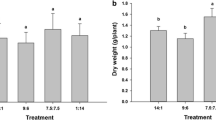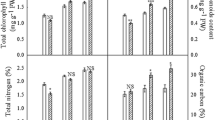Abstract
Malus hupehensis (Pamp.) Rehd. is a widely cultivated rootstock in China. We studied the effect of three NO3 −/NH4 + ratios (100/0, 50/50, and 0/100, molar basis) at total nitrogen (N) concentration of 8 mmoL L−1 in a nutrient solution on M. hupehensis seedlings. Plant biomass, NO3 − and NH4 +concentration, chlorophyll content, respiratory rate, and cellular structure were investigated. M. hupehensis seedlings at the NO3 −/NH4 + ratio of 50/50 had the highest level of fresh weight, dry weight, shoot length, and chlorophyll (a, b, and a + b) content, but the lowest respiration rate in the leaves and roots. In addition, thickness and numbers of palisade and spongy tissue cells of the leaves were greater with this treatment than with other treatments. At the NO3 −/NH4 + ratio of 100/0, the leaves and roots had higher NO3 − concentration and lower NH4 + concentration. However, the opposite trend occurred at the NO3 −/NH4 + ratio of 0/100. Chlorophyll (a, b, and a + b) content was lowest at the NO3 −/NH4 + ratio of 100/0 than at the other ratios. At the NO3 −/NH4 + ratio of 0/100, oxygen (O2) consumption increased in the leaves and roots, and irregular epidermis and cortex cells were observed in the root apical meristematic and mature region. Our results indicated that the NO3 −/NH4 + ratio at 50/50 was suitable for growth of M. hupehensis seedling to achieve the highest biomass production and efficiency.







Similar content being viewed by others
References
Aparicio SR, Marsden P (1969) A rapid methylene blue-basic fuchsin stain for semi-thin sections of peripheral nerve and other tissues. J Microsc 89:139–141
Balkos KD, Britto DT, Kronzucker HJ (2010) Optimization of ammonium acquisition and metabolism by potassium in rice (Oryza satica L. cv. IR-72). Plant Cell Environ 33:23–34
Black BL, Fuchigami LH, Coleman GD (2002) Partitioning of nitrate assimilation among leaves, stems and roots of poplar. Tree Physiol 22:717–724
Bräutigam A, Gagneul D, Weber APM (2007) High-throughput colorimetric method for the parallel assay of glyoxylic acid and ammonium in a single extract. Anal Biochem 362:151–153
Britto DT, Kronzucker HJ (2002) NH4 + toxicity in higher plants: a critical review. J Plant Physiol 159:567–584
Brix H, Dyht-Jensen K, Lorenzen B (2002) Root-zone acidity and nitrogen source affects Typha latifolia L. growth and uptake kinetics of ammonium and nitrate. J Exp Bot 53:2441–2450
Celis-Arámburo TJ, Carrillo-Pech M, Castro-Concha LA, Miranda-Ham ML, Martínez-Estévez M, Echevarría-Machado I (2011) Exogenous nitrate induces root branching and inhibits primary root growth in Capsicum chinense Jacq. Plant Physiol Biochem 49:1456–1464
Chaillou S, Rideout JW, Raper CD, Morot-Gaudry JF (1994) Responses of soy bean to ammonium and nitrate supplied in combination to the whole root system or separately in a split root system. Physiol Plant 90:259–268
Chang J, Liu D, Cao HQ, Chang SX, Wang XY, Huang CC, Ge Y (2010) NO3 −/NH4 + ratios affect the growth and N removal ability of Acorus calamus and Iris pseudacorus in a hydroponic system. Aquat Bot 93:216–220
Chen G, Guo SW, Kronzucher HJ, Shi W (2013) Nitrogen use efficiency (NUE) in rice links to NH4 + toxicity and futile NH4 + cycling in roots. Plant Soil 369:351–363
Claussen W (2002) Growth, water use efficiency, and proline content of hydroponically grown tomato plants as affected by nitrogen scource and nutrient concentration. Plant Soil 247:199–209
Gao Y, Motosugi H, Sugiura A (1992) Rootstock effects on growth and flowering young apple trees grown with ammonium and nitrate nitrogen. J Am Soc Hortic Sci 117:446–452
Guo SW, Schinner K, Sattelmacher B, Hansen U (2005) Different apparent CO2 compensation points in nitrate- and ammonium-grown Phaseolus vulgaris and the relationship to non-photorespiratory CO2 evolution. Physiol Plant 123:288–301
Guo SW, Zhou Y, Shen QR, Zhang FS (2007) Effect of ammonium and nitrate nutrition on some physiological processes in higher plants—growth, photosynthesis, photorespiration, and water relations. Plant Biology 9:21–29
Hoagland DR, Arnon DI (1950) The water culture method for growing plants without soil. Calif Agric Exp Stn Circ 347:1–32
Husted S, Hebbern CA, Mattsson M, Schjoerring JK (2000) A critical experimental evaluation of methods for determination of NH4 + in plant tissue, xylem sap and apoplastic fluid. Physiol Plant 109:167–179
Ishiyama K, Hayakawa T, Yamaya T (1998) Expression of NADH-dependent glutamate synthesis protein in the epidermis and exodermis of rice roots in response to the supply of ammonium ions. Planta 204:288–294
Jackson LE, Burger M, Cavagnaro TR (2008) Roots nitrogen transformations, and ecosystem services. Annu Rev Plant Biol 59:341–363
Lasa B, Frechilla S, Aparicio-Tejo PM, Lamsfus C (2002) Alternative pathway respiration is associated with ammonium ion sensitivity in spinach and pea plants. Plant Growth Regul 37:49–55
Lawlor DW (2002) Carbon and nitrogen assimilation in relation to yield: mechanisms are the key to understanding production systems. J Exp Bot 53:773–787
Liu Y, Lai NW, Gao K, Chen FJ, Yuan LX, Mi GH (2013) Ammonium inhibits primary root growth by reducing the length of meristem and elongation zone and decreasing elemental expansion rate in the root apex in Arabidopsis thaliana. PLoS ONE 8:e61031
Loqué D, von Wirén N (2004) Regulatory levels for the transport of ammonium in plant roots. J Exp Bot 55:1293–1305
Patterson K, Cakmak T, Cooper A, Lager I, Rasmusson AG, Escobar MA (2010) Distinct signalling pathways and transcriptome response signatures differentiate ammonium- and nitrate-supplied plants. Plant Cell Environ 33:1486–1501
Porra RJ, Thompson WA, Kriedemann PE (1989) Determination of accurate extinction coefficients and simultaneous equations for assaying chlorophyll a and b extracted with four different solvents: verification of the concentration of chlorophyll standards by atomic absorption spectroscopy. Biochim Biophys Acta 975:384–394
Qin C, Qian WQ, Wang WF, Wu Y, Yu CM, Jiang XH, Wang DW, Wu P (2008) GDP-mannose pyrophosphorylase is a genetic determinant of ammonium sensitivity in Arabidopsis thaliana. Proc Natl Acad Sci USA 105:18308–18313
Sotiropoulos TE, Mouhtaridou GN, Thomidis T, Tsirakoglou V, Dimassi KN, Therios IN (2005) Effects of different N-sources on growth, nutritional status, chlorophyll content, and photosynthetic parameters of shoots of the apple rootstock MM 106 cultured in vitro. Biol Plant 49:297–299
Tobin AK, Yamaya T (2001) Cellular compartmentation of ammonium assimilation in rice and barley. J Exp Bot 52:591–604
Tylova-Munzarova E, Lorenzen B, Brix H, Votrubova O (2005) The effects of NH4 + and NO3 − on growth, resource allocation and nitrogen uptake kinetics of Phragmites australis and Glyceria maxima. Aquat Bot 81:326–342
Walch-Liu P, Neumann G, Bangerth F, Engels C (2000) Rapid effects of nitrogen form on leaf morphogenesis in tobacco. J Exp Bot 51:227–237
Xu GH, Fan XR, Miller AJ (2012) Plant nitrogen assimilation and use efficiency. Annu Rev Plant Biol 63:153–182
Zhang FC, Kang SZ, Li Fusheng ZJ (2007) Growth and major nutrient concentrations in Brassica campestris supplied with different NH4 +/NO -3 ratios. J Integr Plant Biol 49:455–462
Zhao DL, Reddy KR, Kakani VG, Read JJ, Carter GA (2003) Corn (Zea mays L.) growth, leaf pigment concentration, photosynthesis and leaf hyperspectral reflectance properties as affected by nitrogen supply. Plant Soil 257:205–218
Zhou P, Peng FT, Wei SC, Peng Y (2007) Effects of rhizosphere nitrate and ammonium on the level of cytokinins and leaf growth of Malus hupenensis Rehd. Acta Hortic Sin 34:269–274 (in Chinese with English abstract)
Author information
Authors and Affiliations
Corresponding author
Additional information
Project funding: This work was supported by the Agricultural Comprehensive Development Project of Hebei Province (No. 2012ACDPHP01).
The online version is available at http://www.springerlink.com
Corresponding editor: Zhu Hong
Rights and permissions
About this article
Cite this article
Dong, Y., Zhi, Hh., Zhao, Q. et al. NO3 −/NH4 + ratios affect plant growth, chlorophyll content, respiration rate, and morphological structure in Malus hupehensis seedlings. J. For. Res. 26, 983–991 (2015). https://doi.org/10.1007/s11676-015-0117-x
Received:
Accepted:
Published:
Issue Date:
DOI: https://doi.org/10.1007/s11676-015-0117-x




